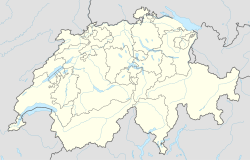Top Qs
Timeline
Chat
Perspective
Cavaglia
Hamlet in Graubünden, Switzerland From Wikipedia, the free encyclopedia
Remove ads
Cavaglia is a small hamlet on the western flank of Val Poschiavo in the canton of Graubünden, Switzerland. Perched at 1,703 m (5,587 ft) on the hanging Plan da l'Alp terrace, it lies roughly 4.7 kilometres (2.9 mi) north-west of Poschiavo village but 700 metres (2,300 ft) higher, making the road distance 11 kilometres (6.8 mi) and the Bernina Line rail journey about 25 minutes.[1] The locality is known for its UNESCO-listed railway station, the nearby Glacier Garden, and a cavern hydropower plant that forms part of the Val Poschiavo cascade.
Remove ads
Geography and climate
Cavaglia occupies a broad glacio-fluvial bench shaped by the retreating Palü Glacier. The cavity-filled Cavagliasch stream drains the shelf, dropping through a gorge before joining the Poschiavino at Puntalta. A MeteoSwiss station records a mean annual temperature of 2 °C and about 1,230 mm of precipitation, roughly half of which falls as snow between October and April.[2]
Transport
Cavaglia railway station is a halt on the Bernina railway, part of the Rhaetian Railway in the Albula/Bernina Landscapes world-heritage corridor. To the south the line hugs the shore of Lago di Poschiavo; to the north it climbs street-running through Le Prese and Spinadascio before the gradient steepens toward Alp Grüm.[3]
Glacier Garden
South-west of the hamlet, melt-water vortices from the last glaciation carved more than 30 "giant's kettles" up to 15 m deep in the greywacke bedrock. Protected since 1996 as the Giardino dei Ghiacciai di Cavaglia, the geosite features walkways and trilingual panels and draws about 35,000 visitors a year on tours coordinated with train schedules.[4] A marked nature trail circles the hamlet and links the Glacier Garden to panoramic viewpoints over Val Poschiavo.[5]
Hydropower
The 7 MW Cavaglia hydro-electric power station (1927) stands in a cavern beneath the terrace, reached by an 800 m pressurised tunnel and service funicular from Palü power station at Palü Lake. Water leaves the plant via the Cavagliasch, then enters a pipeline to Robbia power station at San Carlo.[1][6][7] A short surface spur once linked the cavern to Cavaglia station for heavy equipment deliveries; its trace is still visible in the Bernina-line heritage dossier.[3]
Remove ads
References
Wikiwand - on
Seamless Wikipedia browsing. On steroids.
Remove ads


